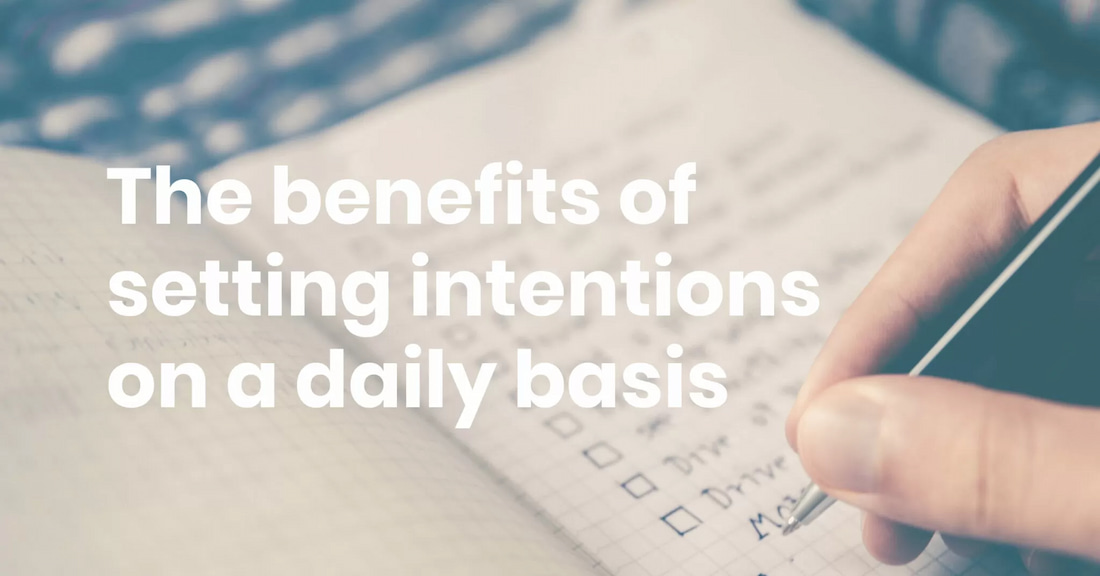
The benefits of setting intentions
The benefits of setting intentions on a daily basis
It can be easy to just let life run away with us. After all, life in the 21st Century is all too often busy, fast-paced and full of things to do. That’s why practices such as yoga and mindfulness meditation are becoming more mainstream, as we try to use these as tools to tackle the stresses and strains of modern life.
Another one of these tools is the practice of setting daily intentions, or an aim or a purpose that we intend to fulfil in order to consciously curate our lives and the way we live them. In fact, many yoga sessions begin with an intention setting practice.
Daily intention setting is empowering and has profound benefits for our wellbeing.
What is intention setting?
When was the last time you went to the supermarket with a mental list of everything you needed – and came out having forgotten at least one item on your list? Probably very recently.
That’s why having a shopping list is important – we can add to it as and when we remember we need something to ensure that we don’t go without. A shopping list is an intention to buy the things we need. We intend to buy potatoes, milk, eggs etc. Intention setting is no different – we intend to do X, Y and Z today in order to live a fulfilled, happy and healthy life.
What’s the difference between goal setting and intention setting?
We can all be forgiven for thinking that setting intentions is the same as setting goals. But in actual fact, they are quite different.
Goal setting places the emphasis on some time in the future. For example, we might have a short-term goal of redecorating the living room by the end of the month. Or a medium-term goal of running a marathon in under four hours in nine months’ time. We might even have a long-term goal of reaching the top of our career game and becoming CEO within the next decade.
It allows us to focus on what we want to achieve and what we need to do to achieve it. As great as goal setting is, it can also cause us to lose mindful focus on the here and now. Also, let’s face it, not all goals are reached, so it can be underpinned by a sense of failure if we don’t meet our own, self-imposed targets.
Intention setting on the other hand tends to focus on today, and for this reason, it goes hand in hand with mindfulness practices that force us to be present and aware of the right now.
Setting intentions, like mindfulness practice, is a daily process that encourages us to identify our values and what we stand for, allowing us to create the shopping list of all the things we’re going to be today.
Since setting intentions is about who we are, it’s also about how we impact the world around us, and the people in it.
In many ways then, intention setting is the stalwart of goal setting – living our true identity on a daily basis supports good emotional intelligence which in turn supports our ability to achieve our longer term goals.
How do I practice intention setting?
There are no hard and fast rules on how to practice intention setting, instead, it’s what works best for you. Some people like to write their intentions down each day, others prefer to say them out loud. If you like to have a record, then writing them down will probably work best for you.
You can write them on a notepad by your desk, on a piece of paper that you pin somewhere you’ll pass regularly such as by the sink or the kettle or you can use a daily journal to set your intentions.
Setting intentions in the morning for the day ahead makes most sense, leaving an evening journaling session for reflecting on your day and figuring out what’s serving you, and what isn’t.
Once you’ve decided on how you’re going to set your intentions:
- Find quietude where you won’t be disturbed for a few moments
- Consider the day ahead and what you might encounter that you’d like to set an intention for – for example a tricky work meeting when you might intend to be more present or a drinks party where you might intent to make considered, healthy choices
- State your intentions, either out loud or in the written word
- Be clear on each intention to make them more actionable
- Focus on the positive, so “I will…” rather than “I won’t…”
- Make each intention simple
Here’s some examples of daily intention setting:
- Today, I will be mindfully present in all that I do
- Today, I will be grateful for the abundance in my life
- Today, I will be receptive to the beauty of nature
- Today, I will bring joy to the life of another
- Today, I will exercise and eat well
- Today, I will accept help
- Today, I will prioritise my own mental wellbeing
How will I benefit from daily intention setting?
Setting daily intentions can have a positive impact on anxiety. Recent studies have shown that setting daily intentions can “improve self-control, help towards breaking bad habits and change unwanted behaviours”. [1] If we can change negative behaviours and create positive change through these tools, then we can reduce feelings of overwhelm and anxiety. [2]
Intention setting can also help us towards achieving our goals, which has enormous possibilities for improving our overall mental wellbeing, self-esteem and social standing. [3] By identifying and committing to our goals via daily incremental intentions, we’re much more likely to be engaged in meeting our goals, and making intention setting second nature.
Daily intention setting also has the benefit of making us more productive, starting the day on a positive, empowered note and opening our eyes and minds to things we may not otherwise notice if we didn’t commit to being more mindful and in the moment.
Intention setting can apply to our physical health and fitness too. For example, we can set an intention before we write that shopping list, that we’re going to respect our body for its strength this week, and we’re going to nourish it with health-giving foods.
Or we might set an intention before exercise that no matter how much it hurts, we’re going to exercise to care for our muscles, bones, heart and lungs. (As a happy, serendipitous side point to note, adding movement to our day also supports good mental health.)
If daily life is frustrating you and you feel like you’re wandering a little aimlessly, try setting your intentions on a daily basis. It could be the simple tool you need, for effective change.
References
1) Gollwitzer, P., 1999. Implementation Intentions: Strong Effects of Simple Plans. American Psychologist, 1999, 54, 493-503. [Accessed 31 August 2022]
2) Smyth, J. M., Johnson, J. A., Auer, B. J., Lehman, E., Talamo, G., & Sciamanna, C. N., 2018. Online Positive Affect Journaling in the Improvement of Mental Distress and Well-Being in General Medical Patients With Elevated Anxiety Symptoms: A Preliminary Randomized Controlled Trial. JMIR mental health, 2018, 5(4). [Accessed 31 August 2022]
3) Gollwitzer, P & Brandstätter, V., 1997. Implementation Intentions and Effective Goal Pursuit. Journal of Personality and Social Psychology, 1997, 73(1), 186-199. [Accessed 31 August 2022]


